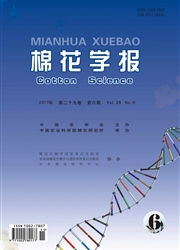

 中文摘要:
中文摘要:
以单作棉为对照,采取池栽试验方法,设置麦棉自然根系(根系和肥水均可相互通过)、麦棉纱网隔根(肥水可相互通过,根系不能相互通过)和麦棉塑膜隔根(根系和肥水均不能相互通过)3种麦棉复合根系群体,研究了麦棉套作对棉花根系生理特性的影响。结果表明,麦棉自然根系和纱网隔根复合群体降低了麦棉共生期的棉花根系活力,而麦棉塑膜隔根提高了棉花根系活力;麦棉套作,无论隔根与不隔根,均降低了麦棉共生期内的棉花根系内源保护酶活性及可溶性蛋白含量;小麦收获后,棉花根系内源保护酶活性和可溶性蛋白含量均比共生期有不同程度的改善,但麦棉隔根复合根系群体仍然低于麦棉自然根系。
 英文摘要:
英文摘要:
According to the single-planting cotton as CK, the effect of the different composite root pop ulation of wheat-cotton double cropping system on cotton root growth was studied by setting three treatments, i.e. wheat-cotton double cropping system in which the roots of wheat and cotton mixed naturally(WCRM), wheat-cotton double cropping system in which the roots of wheat and cotton separated with nylon net (WCRN), and wheat-cotton double cropping system in which the roots of wheat and cotton separated with plastic film(WCRP). The results showed that: in the symbiotic period of wheat and cotton, the cotton root activity reduced in WCRM and WCRN, and increased in WCRP. The activity of SOD, POD, CAT and soluble protein content of cotton root reduced under the system of separated or united roots of wheat and cotton, improved after wheat harvested in various degrees in the symbiotic period, but the activity and soluble protein in WCRP were lower than those in WCRM.
 同期刊论文项目
同期刊论文项目
 同项目期刊论文
同项目期刊论文
 期刊信息
期刊信息
